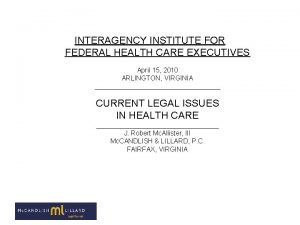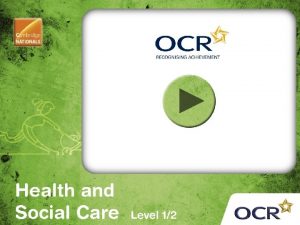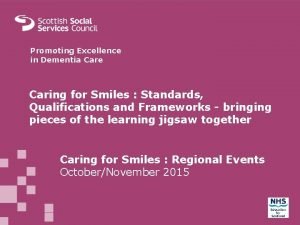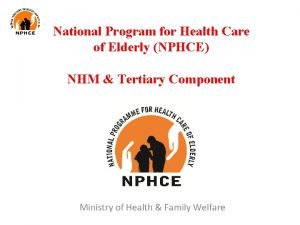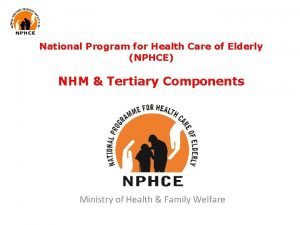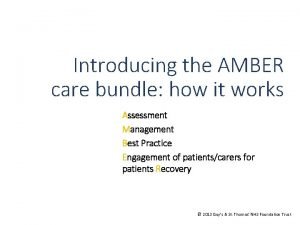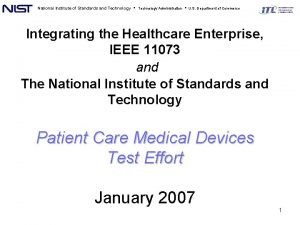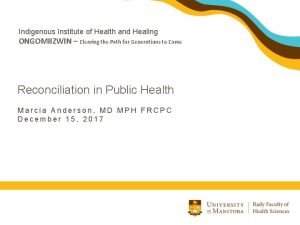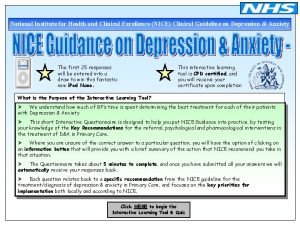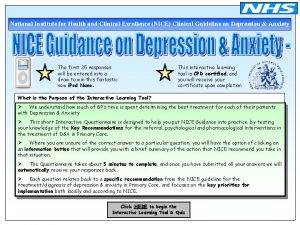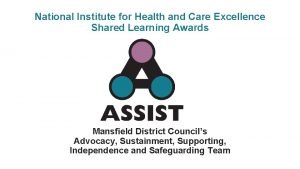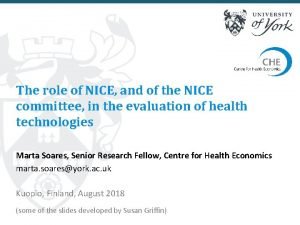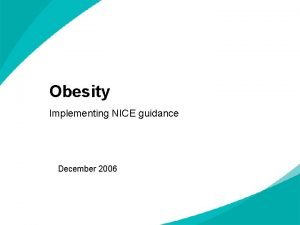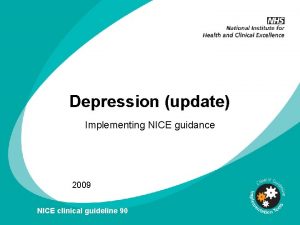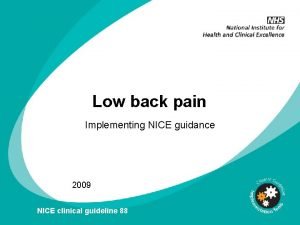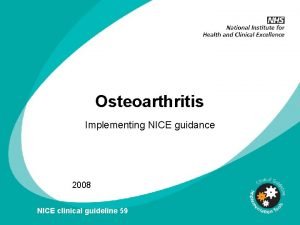National Institute for Health and Care Excellence NICE
























- Slides: 24

National Institute for Health and Care Excellence NICE guidance for social care Jane Moore Implementation Consultant (London region)

What is NICE? The National Institute for Health and Care Excellence (NICE) is the independent organisation responsible for providing national guidance on the promotion of good health and the prevention and treatment of ill health.

The role of NICE • To improve quality and productivity • To identify good clinical, public health and social care practice using the best available evidence • To help resolve uncertainty for the public, and professionals • To reduce variation in the availability and quality of practice and care.

Our guidance Guidelines: • health • public health • social care • medicines practice Health technologies: • medicines • interventional procedures • medical technologies Based on the best available evidence, they describe what works and is value for money

Regulation - CQC Andrea Sutcliffe, Chief Inspector for Adult Social Care CQC “At the CQC we are asking the questions that matter to people. We’re asking whether services are safe, caring, effective, responsive to people’s needs, and well led. “And the way that we can do this is by identifying key lines of enquiry – so the questions that we will ask when we go out on inspections. We will also identify what the characteristics are of the services that we see, so whether they are good, outstanding, require improvement or are inadequate. “This quality standard will inform the questions that we ask, and help us to provide the understanding of what ‘good’ and ‘outstanding’ practice looks like in this area. ” https: //www. youtube. com/watch? v=Rxw. HM 0 Jsdy. I

Relevant guidance Residential care: Supporting people to live well with dementia Mental wellbeing of older people in residential care Managing medicines in care homes Older people with social care needs and multiple long-term conditions Transition between inpatient hospital settings & community or care home settings Dementia: independence and wellbeing Falls in older people Home Care: Oral health for adults in care homes Delivering personal care to older people in their own homes Nursing care: End of life care for adults Drug & Alcohol services: Delirium in adults Mental illness and substance misuse Pressure ulcers Drug misuse in over 16 s Nutrition Alcohol use disorders Infection prevention and control Alcohol: preventing harmful use Learning disability: Challenging behaviour in people with learning disability

Relevant guidance in development In development: • Adult social care: improving people’s experience (Feb 18) • Adults with complex needs (including LD) and mental health needs; social work interventions (TBC) • Advocacy for adults with health and social care needs (TBC) • Care and support of older people with learning disabilities (May 18) • Decision making and mental capacity (July 18) • Independent living: supporting independence & preventing isolation (TBC) • Intermediate care including re-ablement (July 17) • Learning disabilities and behaviour that challenges (March 18) • Safeguarding adults in care homes (TBC) • Supporting adult carers (July 19)

Why use NICE guidance? • Based on the best available research • Effectiveness: what works and in what population • Cost-effectiveness: value for money approaches to national and local priorities • Reduce variation and inequalities • Improve health and wellbeing outcomes • Supports quality improvement activities (good news stories) • Can help address incidents (action plans) • Supports the case for investment (value for money) • Demonstrates quality to commissioners (tenders, contract, quality monitoring) • Help answer questions around quality from CQC • Staff can understand explain care delivery (CPD) • Demonstrate quality to service users & families

Core principles of all NICE guidance • Comprehensive evidence base • Expert input • Patient and carer involvement • Independent advisory committees • Genuine consultation • Regular review • Open and transparent process

Example: Guideline

Example: Pathway NG 27 Transition between health & social care

What are NICE quality standards? A set of systematically developed recommendations to guide decisions for a particular area of care or health issue Evidence Guidance Research studies - experimental and observational, quantitative and qualitative, process evaluations, descriptions of experience, case studies Quality Standards A NICE quality standard is a concise set of statements designed to drive and measure priority quality improvements.

NICE quality standards Typically 6 – 8 statements Based on best available evidence such as NICE guidance and other evidence sources accredited by NICE Include measures to help inform local quality improvement work Define priority areas for quality improvement

How to use NICE quality standards Help to identify local priorities for quality improvement • NICE quality standards can highlight key areas for improvement. An initial assessment should consider: relevance to the organisation, how services compare, what evidence is available, actions to improve, risks of not improving Driving quality improvement • Once you have identified gaps and priorities, use quality standard measures to improve quality of services: establish a project team, develop an action plan, assess cost and service impact, develop a business case, measure a baseline, deliver actions and evaluate success • See Into Practice Guide www. nice. org. uk/intopracticeguide

EG. Ensure wellbeing and safeguarding responsibilities are met NICE Quality Standards can help organisations to: • Provide meaningful, person-centred activities – Supporting people to live well with dementia – Mental wellbeing of older people in residential care • Reduce medication errors – Medicines management in care homes • Monitor for malnutrition – Nutrition support in adults • Prevent falls – Falls guideline and quality standard • Reduce healthcare-related infections – Infection prevention and control • Avoid delirium and monitor for depression – Delirium – Mental wellbeing of older people in residential care

Tools and Resources to save you effort We provide a range of resources to help maximise uptake and use of evidence and guidance. Into Practice Guide Online learning resources Clinical case scenarios Local practice collection NICE and BNF apps Field team Baseline assessment/ tools Costing reports and templates Medicines Information www. nice. org. uk/abpit/what-we-do/into-practice

Includes: ü Tips to help staff conduct oral health assessment ü Handy assessment tool ü Understanding how dental pain can affect residents’ general wellbeing

For service users: ü What to expect from a good homecare service ü Importance of a home care plan ü What to do if you’re unhappy with the standard of care you’re receiving

Accessing the guidance Search bar for free text www. nice. org. uk Or, try NICE Pathways Search by categories, dates, state of development


Population groups http: //www. nice. org. uk/guidance/population-groups/older-people


NICE Pathways

Staying up to date with NICE • Website www. nice. org. uk • NICE News - monthly e-newsletter • Social Care Stakeholder Update – monthly bulletin • 100, 000+ people follow us on Twitter @NICEcomms • General enquiries nice@nice. org. uk
 National electronics complex of pakistan (necop)
National electronics complex of pakistan (necop) Australian primary health care research institute
Australian primary health care research institute Interagency institute for federal health care executives
Interagency institute for federal health care executives Health and social care component 3
Health and social care component 3 Cambridge national health and social care
Cambridge national health and social care Ocr cambridge nationals health and social care
Ocr cambridge nationals health and social care Care value base health and social care
Care value base health and social care Primary care secondary care tertiary care
Primary care secondary care tertiary care Centre national d'excellence en santé mentale
Centre national d'excellence en santé mentale Whooley questions nice
Whooley questions nice Promoting excellence in dementia care
Promoting excellence in dementia care Nphce program
Nphce program Nphce
Nphce Amber resuscitation
Amber resuscitation National health programme for children in india
National health programme for children in india Spike unist internship
Spike unist internship National institute of standards and technology
National institute of standards and technology National institute for food and drug surveillance
National institute for food and drug surveillance Swedish national road and transport research institute
Swedish national road and transport research institute Health and environmental sciences institute
Health and environmental sciences institute Institute of health and healing
Institute of health and healing Fares haddad hca
Fares haddad hca Mozambique national institute of meteorology
Mozambique national institute of meteorology National assistive technology research institute
National assistive technology research institute Toshiba 1b japanasia
Toshiba 1b japanasia


